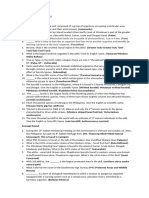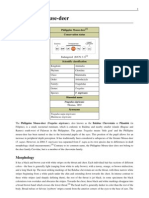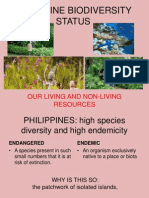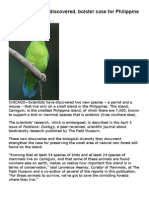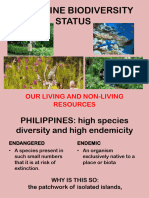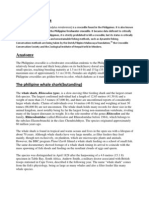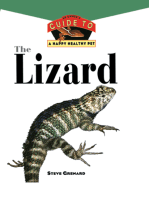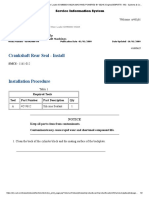JIDC 08 01 01 Maala-1-17-3
JIDC 08 01 01 Maala-1-17-3
Uploaded by
Jane Carol MallariCopyright:
Available Formats
JIDC 08 01 01 Maala-1-17-3
JIDC 08 01 01 Maala-1-17-3
Uploaded by
Jane Carol MallariOriginal Title
Copyright
Available Formats
Share this document
Did you find this document useful?
Is this content inappropriate?
Copyright:
Available Formats
JIDC 08 01 01 Maala-1-17-3
JIDC 08 01 01 Maala-1-17-3
Uploaded by
Jane Carol MallariCopyright:
Available Formats
Endangered Philippine Wildlife Species with Special Reference to the Philippine Eagle and Tamaraw 3
meat, which is a delicacy in some Asian countries. Other non-governmental conservation groups such as
the World Wildlife Fund Philippines (Kabang Kalikasan ng Pilipinas) and large business conglomerates
like Nokia Philippines, Megaworld Corporation and International Container Terminal Services
Incorporated have supported the government's campaign to protect the whale shark. The Philippine
Daily Inquirer a leading Philippine newspaper also supports the save the whale shark campaign. Other
endangered Philippine species are the Hawksbill turtle (Eretmochelys imbricata), Olive Ridley turtle
(Lepidochelys olivacea), Leatherback turtle (Dermochyles coriacea), Philippine crocodile also known as
Philippine freshwater crocodile and Mindoro crocodile (Crocodylus mindorensis), Indo-Pacific croco-
dile or salt water crocodile (Crocodylus porosus), Mindoro bleeding heart (Gallicolumba platenae),
Mindoro bleeding heart (Ducula mindorensis), lesser eagle owl (Mimizuki gurneyi), Philippine eagle
owl (Bubo philippensis), silvery kingfisher (Alcedo argentata), Mindoro hornbill (Penelopides min-
dorensis), celestial monarch (Hypothymis coelestis) and Isabela oriole (Oriolus isabellae). The
Philippines - Japan Crocodile Farming Institute (CFI) based in Palawan Island has successfully bred the
Crocodylus mindorensis in captivity. Only the endangered terrestial mammals (cloud rats, fruit bats,
deers, wild pig and tamaraw) and the Philippine eagle will be described in this paper.
2.1 Cloud Rats
Cloud rats are gentle and lovely rodents found only in the Philippine. Six species of cloud rats inhabit
the Philippine. These are the Northern Luzon slender-tailed cloud rat (Phloeomys pallidus), Southern
Luzon slender-tailed cloud rat (Phloeomys cumingi), giant bushy-tailed cloud rat (Crateromys schaden-
bergi), Ilin Island cloud rat (Crateromys paulus), Dinagat Island cloud rat (Crateromys australis) and
Panay Island bushy-tailed cloud rat (Crateromys heaneyi). The Panay bushy-tailed cloud rat and the
Ilin-hairy tailed cloud rat are extremely endangered while the Ilin hairy-tailed cloud rat found only in the
Ilin Island south of Mindoro is on the verge of extinction. Others claim it is already extinct. The smallest
is the Crateromys paulus. The Phloeomys cumingi and Phloeomys pallidus are still off the endangered
list because there is still a healthy population of these species in the wild. Unlike their parasite and dis-
ease carrying cousin rats in urban places, cloud rats are forest dwellers. They are slow moving creatures
but are excellent tree climbers. Cloud rats are nocturnal creatures spending most of the day sleeping in
the hole of large trees. Their diet is simple consisting mostly of tender young leaves, bananas, guavas,
and young corns (Novak, 1999). Survival of cloud rats is threatened by hunting and wide scale defor-
estation. Cloud rats are usually hunted for their meat, which is a favorite finger food or pulutan during
drinking session in rural areas. Others keep them as pets. Cloud rats are among the wildlife species pro-
tected by the Haribon Foundation for the Conservation of Natural Resources a member of the World
Conservation Union with linkages with a number of conservation groups nationally and internationally.
Basic studies on the biology and health aspects of cloud rats should be encouraged to complement vari-
ous on-going conservation measures. In the Philippines, Maala and Arreola (1996) described the hair
cuticles of the cloud rat from those of flying lemur and Philippine monkey by means of scanning elec-
tron microscopy. Based on the result of their study the three species could be differentiated from each
other through the cuticular patterns of their hair. A study on the anatomy of the cloud rat is presently
undertaken at the Institute of Biological Sciences, University of the Philippines Los Banos.
2.2 Flying Foxes
Flying foxes or fruit bats are forest dwellers, which subsist mainly on forest fruits. They are known
You might also like
- Failte The Girl For Me PDFDocument2 pagesFailte The Girl For Me PDFBilal0% (2)
- Wedding Day Questionnaire FormDocument10 pagesWedding Day Questionnaire Formhananiah100% (1)
- Flora and FaunaDocument8 pagesFlora and Faunaamboy glinogoNo ratings yet
- 50 Critically Endangered Species in The PhilippinesDocument12 pages50 Critically Endangered Species in The Philippinesdelacruzylanna01No ratings yet
- Republic Acts and Ecological Animals ReviewerDocument3 pagesRepublic Acts and Ecological Animals ReviewerMa Juwan Xyza MalazaNo ratings yet
- Yz ThineDocument19 pagesYz ThineMhel ChieeNo ratings yet
- Module 7 - PROTECTING THE ENDANGERED SPECIEDocument11 pagesModule 7 - PROTECTING THE ENDANGERED SPECIEjerwin remocalNo ratings yet
- Saving The Philippine Eagle As A Way of Saving The Nation'S FreedomDocument5 pagesSaving The Philippine Eagle As A Way of Saving The Nation'S FreedomJinky FernandezNo ratings yet
- Endangered and Endemic SpeciesDocument6 pagesEndangered and Endemic SpeciesLoveCLNo ratings yet
- Wildlife National Quiz Bee Questions 2015Document2 pagesWildlife National Quiz Bee Questions 2015Vohn Archie EdjanNo ratings yet
- PilandokDocument4 pagesPilandokpatricksvdNo ratings yet
- Flora Fauna Biodiversity Conservation of The PhilippinesDocument4 pagesFlora Fauna Biodiversity Conservation of The PhilippinesBhea Lyn SomblingoNo ratings yet
- PPTDocument40 pagesPPTMhaithan Hernandez CaliuagNo ratings yet
- Philippine BiodiversityDocument40 pagesPhilippine BiodiversityJoy Eva100% (2)
- Endangered Species TranscriptDocument5 pagesEndangered Species TranscriptJerric CristobalNo ratings yet
- Biodiversity PDFDocument78 pagesBiodiversity PDFRaymond LuberiaNo ratings yet
- Term Paper Phil EagleDocument18 pagesTerm Paper Phil Eaglejoy herbasNo ratings yet
- "Extinct" Amphibians Rediscovered After Nearly Half A CenturyDocument3 pages"Extinct" Amphibians Rediscovered After Nearly Half A CenturyCHRISTIAN SORIANONo ratings yet
- The Philippine MenagerieDocument33 pagesThe Philippine MenagerieJC MagsinoNo ratings yet
- Endangered Animals1Document11 pagesEndangered Animals1Gloria TumacasNo ratings yet
- Presentation1 HISTORYDocument75 pagesPresentation1 HISTORYarroganciahNo ratings yet
- Priority Notes - Biodiversity 2016Document6 pagesPriority Notes - Biodiversity 2016Vohn Archie EdjanNo ratings yet
- BIRDSDocument2 pagesBIRDSmaldelossantoshomemarkNo ratings yet
- BIOL 181 - Corridor ADocument20 pagesBIOL 181 - Corridor AParagoso FhemNo ratings yet
- Psy101 Sulibran-BiodiversityDocument6 pagesPsy101 Sulibran-BiodiversityKent VillelaNo ratings yet
- Two New Species Discovered, Bolster Case For Philippine ConservationDocument47 pagesTwo New Species Discovered, Bolster Case For Philippine Conservationallanlopez_2009No ratings yet
- Biodiversity and Conservation: Ms. Jannet Broas Ms. Celeste Desingaño Ms. Gladys Guirre Ms. Jenalyn SampangDocument55 pagesBiodiversity and Conservation: Ms. Jannet Broas Ms. Celeste Desingaño Ms. Gladys Guirre Ms. Jenalyn SampangKaye SolanoyNo ratings yet
- A Research On The Biodiversity of The Northern Sierra Madre Natural ParkDocument23 pagesA Research On The Biodiversity of The Northern Sierra Madre Natural ParkRhysand NightcourtNo ratings yet
- 9 Endangered Species in The PhilippinesDocument9 pages9 Endangered Species in The PhilippinesGoDonJ TVNo ratings yet
- WALADocument5 pagesWALAJohn Marines EstiocoNo ratings yet
- M9 Learning ActivityDocument5 pagesM9 Learning ActivityMaria Louella MagadaNo ratings yet
- Endemic Species Found in The Albay Biosphere ReserveDocument13 pagesEndemic Species Found in The Albay Biosphere ReserveClark100% (1)
- World Wildlife DayDocument35 pagesWorld Wildlife DayLeah Liza CasandaNo ratings yet
- JIDC 08 01 01 Maala-1-17-4Document1 pageJIDC 08 01 01 Maala-1-17-4Jane Carol MallariNo ratings yet
- Philippine Mouse-Deer or Balabac Chevrotain: Scientific Name: Tragulus NigricansDocument4 pagesPhilippine Mouse-Deer or Balabac Chevrotain: Scientific Name: Tragulus NigricansgabNo ratings yet
- Endagered Species in The PhilippinesDocument3 pagesEndagered Species in The PhilippinesBusilaoco, Frances Eve M.No ratings yet
- Breeding BettaDocument8 pagesBreeding BettaadaaamNo ratings yet
- Endemic Species in The Philippines: 1. Philippine Eagle (Pithecophaga Jefferyi)Document6 pagesEndemic Species in The Philippines: 1. Philippine Eagle (Pithecophaga Jefferyi)Aaron AlvaranNo ratings yet
- Lecture 4 (Living Resources)Document40 pagesLecture 4 (Living Resources)ANGELICAJONES TENERIFENo ratings yet
- DraftDocument8 pagesDraftDence De LaraNo ratings yet
- Biodiversity WILDLIFE ACTDocument32 pagesBiodiversity WILDLIFE ACTEmil EnriquezNo ratings yet
- Flora and FaunaDocument17 pagesFlora and FaunaKrisha Apale DingdingNo ratings yet
- Mindanao Animals: Group 3Document9 pagesMindanao Animals: Group 3Christine RoanNo ratings yet
- Mandrillus Sphinx - Sexual Dimorphism and Physical Diversity of Individuals in Relation To Social StatusDocument14 pagesMandrillus Sphinx - Sexual Dimorphism and Physical Diversity of Individuals in Relation To Social StatusJonathan Schwartz100% (2)
- JIDC 08 01 01 Maala-1-17-2Document1 pageJIDC 08 01 01 Maala-1-17-2Jane Carol MallariNo ratings yet
- STS IUCN Red ListDocument2 pagesSTS IUCN Red ListLexter CrudaNo ratings yet
- The Philipine CrocodileDocument1 pageThe Philipine Crocodilebrionytallis08No ratings yet
- JIDC 08 01 01 Maala-1-17-1Document1 pageJIDC 08 01 01 Maala-1-17-1Jane Carol MallariNo ratings yet
- Pal StudyDocument15 pagesPal StudyclariselysaabiquepadulNo ratings yet
- Philippine Crocodile: Mindoro Crocodile, The Philippine Freshwater Crocodile, The BukarotDocument3 pagesPhilippine Crocodile: Mindoro Crocodile, The Philippine Freshwater Crocodile, The BukarotRap Andrei Iyah PerezNo ratings yet
- 10 Endangered Species That Is Located in The Philippine ArchipelagoDocument29 pages10 Endangered Species That Is Located in The Philippine ArchipelagoMystic BoyNo ratings yet
- Which Biodiversity Hotspot Did You Choose To Write AboutDocument2 pagesWhich Biodiversity Hotspot Did You Choose To Write AboutDyrell Ann SantiagoNo ratings yet
- Philippine CrocodilesDocument2 pagesPhilippine CrocodilesPrecious FranzNo ratings yet
- Addendum2 WildlifeDocument11 pagesAddendum2 WildlifeVohn Archie EdjanNo ratings yet
- Myka ScienceDocument14 pagesMyka ScienceMJ AndrabadoNo ratings yet
- Captive Individuals of Endangered Philippine Raptors Maintain Native Feather MitesDocument3 pagesCaptive Individuals of Endangered Philippine Raptors Maintain Native Feather MitesJimmy BinsasiNo ratings yet
- Landbird Conservation Finches GalápagosDocument4 pagesLandbird Conservation Finches GalápagosJohn OsborneNo ratings yet
- Assignment Scinece Miggy December 7 2020Document5 pagesAssignment Scinece Miggy December 7 2020Juztine Aquino AmbrosioNo ratings yet
- My First Book about the Animal Alphabet of the Philippines: Amazing Animal Books - Children's Picture BooksFrom EverandMy First Book about the Animal Alphabet of the Philippines: Amazing Animal Books - Children's Picture BooksNo ratings yet
- Animal Extinction and Preservation - Animal Books | Children's Animal BooksFrom EverandAnimal Extinction and Preservation - Animal Books | Children's Animal BooksNo ratings yet
- JIDC 08 01 01 Maala-1-17-4Document1 pageJIDC 08 01 01 Maala-1-17-4Jane Carol MallariNo ratings yet
- JIDC 08 01 01 Maala-1-17-2Document1 pageJIDC 08 01 01 Maala-1-17-2Jane Carol MallariNo ratings yet
- JIDC 08 01 01 Maala-1-17-5Document1 pageJIDC 08 01 01 Maala-1-17-5Jane Carol MallariNo ratings yet
- JIDC 08 01 01 Maala-1-17-1Document1 pageJIDC 08 01 01 Maala-1-17-1Jane Carol MallariNo ratings yet
- 1625563717adas Ii Senior High SchoolDocument2 pages1625563717adas Ii Senior High SchoolJane Carol MallariNo ratings yet
- PER-QF-04 POSITION DESCRIPTION FORM - CSC Revised 2017 (Administrative Assistant II (DEMO) )Document2 pagesPER-QF-04 POSITION DESCRIPTION FORM - CSC Revised 2017 (Administrative Assistant II (DEMO) )Jane Carol MallariNo ratings yet
- PER-QF-04 POSITION DESCRIPTION FORM - CSC Revised 2017 (Accountant I)Document2 pagesPER-QF-04 POSITION DESCRIPTION FORM - CSC Revised 2017 (Accountant I)Jane Carol MallariNo ratings yet
- Literacy Year 1 Week 10 - Letter NDocument5 pagesLiteracy Year 1 Week 10 - Letter NmendolavendorNo ratings yet
- Assembly Language ProgrammingDocument20 pagesAssembly Language ProgrammingRaj Kumar100% (3)
- Master Circular Auto Loan 2018Document351 pagesMaster Circular Auto Loan 2018Vikash MishraNo ratings yet
- Art of Arabic CalligraphyDocument5 pagesArt of Arabic CalligraphyAaea LisboaNo ratings yet
- RN518 MWDocument54 pagesRN518 MWDominiqueNo ratings yet
- 6 Minute English Flexible WorkingDocument5 pages6 Minute English Flexible WorkingfebyNo ratings yet
- Case EuroDisneyDocument28 pagesCase EuroDisneyEsthefania Rodriguez PalominoNo ratings yet
- 216B 226B 232B 242B Skid Steer Loader BXM00001-04224 (MACHINE) POWERED BY 3024C Engine (SEBP3770 - 65) - Systems & Components 7 UBA PDFDocument2 pages216B 226B 232B 242B Skid Steer Loader BXM00001-04224 (MACHINE) POWERED BY 3024C Engine (SEBP3770 - 65) - Systems & Components 7 UBA PDFubaldo caraballoNo ratings yet
- Bài tập chuyển danh từ sang dạng số nhiều NgôDocument12 pagesBài tập chuyển danh từ sang dạng số nhiều NgôThu Trang VũNo ratings yet
- How To See Dna With Naked EyeDocument13 pagesHow To See Dna With Naked EyeShabnam Muhammed Sholay50% (2)
- PE 11 Second Periodical ExamDocument2 pagesPE 11 Second Periodical ExamPrincess Dianne EsquivelNo ratings yet
- Hardware Design Considerations Using A BLDC Mo: Application ReportDocument9 pagesHardware Design Considerations Using A BLDC Mo: Application Reportvenkat venkyNo ratings yet
- Book Reviews For Indias New Capitalists by Harish DamodaranDocument5 pagesBook Reviews For Indias New Capitalists by Harish DamodaranKisholoy AntiBrahminNo ratings yet
- Institute of Management, Nirma University: Digital MarketingDocument17 pagesInstitute of Management, Nirma University: Digital MarketingAkash LohiNo ratings yet
- Darlene's First 100 Days ReportDocument12 pagesDarlene's First 100 Days ReportAvel Manansala0% (1)
- Writing ReviewsDocument29 pagesWriting ReviewsLourence Albert Moreno MoleñoNo ratings yet
- Revisiting Eurocode 8 Formulae For Periods of Vibration and Their Employment in Linear Seismic AnalysisDocument13 pagesRevisiting Eurocode 8 Formulae For Periods of Vibration and Their Employment in Linear Seismic AnalysisAnonymous imkwF8N7TeNo ratings yet
- 2009 Longleaf Flatwoods ReserveDocument71 pages2009 Longleaf Flatwoods Reservebradley_waltersNo ratings yet
- ASTM C 418 Standard Test Method For Abrasion Resistance of Concrete by SandblastingDocument3 pagesASTM C 418 Standard Test Method For Abrasion Resistance of Concrete by SandblastingILSEN N. DAETNo ratings yet
- 10.0 PP 192 205 Liszts LiederDocument14 pages10.0 PP 192 205 Liszts LiederCobi AshkenaziNo ratings yet
- Profile Afzal Sarwar 2011Document10 pagesProfile Afzal Sarwar 2011Afzal SarwarNo ratings yet
- Fertilizer Industry Analysis: Submitted To: Mr. Hafiz WaqarDocument39 pagesFertilizer Industry Analysis: Submitted To: Mr. Hafiz WaqarRafi AghaNo ratings yet
- Astronomy, Vol. 49.6 (June 2021)Document68 pagesAstronomy, Vol. 49.6 (June 2021)georgetacaprarescuNo ratings yet
- Zong Et Al (2024)Document14 pagesZong Et Al (2024)Ryan PratamaNo ratings yet
- Report Iran's Reserve of Last Resort PDFDocument34 pagesReport Iran's Reserve of Last Resort PDFAnthony_ScotNo ratings yet
- Haider Jamal 8618Document19 pagesHaider Jamal 8618Haider JamalNo ratings yet
- 1 PL Eur e 2016Document20 pages1 PL Eur e 2016DiditNo ratings yet
- Deposits Notes CreditDocument7 pagesDeposits Notes CreditMa. Goretti Jica GulaNo ratings yet









